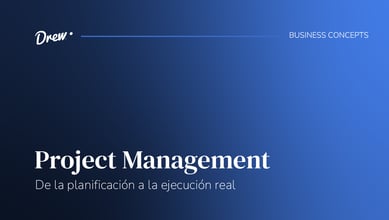Project Management
Everything you need to know about the project management of an organization.
Introduction
In a company, there are many coexisting functional areas that make business work properly: management, finances, administration, production/operations, quality, marketing, human resources, project management, process, logistics. In order to reach its organizational objectives, it is vital that all these areas have the same purpose and business strategy.
Next, we are going to delve into the Marketing Area: what is it, which are its main functions, its biggest challenges, etc
What will you find on this page?
Definition of the project management area
Project Managers: What is their role in project management
Project Managers: What is their role in project managementLeer completo
Delve deep into our
Business Concepts

Project Management: from planning to actual execution

What is the Burndown chart?

What is the Fibonacci sequence?
A short history of its beginning and development over time
Importance of project management
Having an area especialized in project management, together with excellent computer services, adds great value to a company that wants to be relevant in these present times. When you maximize the reaction ability of the employees, you can spend less money and obtain greater added value in terms of the quality of the product
Project management guides success by aligning resources, deadlines and objectives to turn visions into realities.
Project management into organizations
Main responsibilities of the area within the company
Different methodologies in the project management area
-
AGILE: It is characterized by great flexibility. It allows you to process projects in several small cycles. In general, it is better for dynamic projects, subject to constant changes and regular revisions. The Project Manager will divide the project into "sprints" that will have to adapt constantly to the new requirements of customers. By using AGILE methodology, you provide great adaptability to your work team but subject to a regular iteration.
-
Adaptative Project Framework:It was created to provide a solution to projects that are sensitive to suffer modifications and changes throughout their development; this approach focuses on adapting the process to the needs that may arise. It is presented as the counterpart of the traditional or linear approach where each task has a previous and a following one.
-
Kanban: Kanban method is based on the correct use of time, project dimension, and estimate costs; it deletes "sprints" to focus on the idea of continuous delivery. Visual symbols are used to keep the team alert about the quantity or quality of the desired products (Kanban means "signal"). It became popular in the 1940s in the Japanese Toyota factory. It is usually combined with Scrum methodology to get a better result.
-
Extreme Programing: Based on the agile structure, Extreme Programing, known as XP, was developed in the 90s as a short-cycle work method; its main goal is to deliver a high-quality product and to achieve excellent customer service. It is focused on small tasks, accompanied by specific software to assure high-quality products.
-
PERT: The Project Evaluation Review Technique was designed specifically for manufacturing industries. With this methodology, you get a better development because it takes into account the necessary time to develop a task in such a way that the result is according to the defined time and budget.
-
Waterfall: Created to provide a solution to projects that had many changes and approaches, this methodology focuses on adapting the process to new needs and requirements that may arise. Waterfall methodology is a traditional and conservative approach and it is usually used in construction sectors where every step depends on a previous one and conditions the following one, that is to say that it is subject to abrupt or untimely changes. Tasks will be carried out in a linear and and string-like way, from beginning to end.
-
PRINCE2: Projects in Controlled Environments methodology has become popular in places such as the UK. It is a flexible and agile methodology to work with. Its focus is on the time of delivery of products as well as in the money needed according to the established budget. There is a clear division of tasks for each worker so there are no misunderstandings (in theory) as regards who should do each task, which guarantees a successful final result.
-
Scrum: With this methodology, you may overcome obstacles more quickly than with the waterfall methodology. It is also based on the AGILE structure and is focused on the interactive collaboration of all the participants of the project. The leader of the project will take the name of Scrum Master and will divide the "sprints" according to the time limits, such as in one, two or three weeks. It is very popular because this methodology provides efficiency and competitiveness to the company, making the most of the work time and resulting in an iterative and successful process.
-
proposed goals,
-
the type of project according to its magnitude and size,
-
the way employees work,
-
types of customers and their expectations,
-
the goals of the organization,
-
work structure (remote or in-office),
-
every factor you think is important to assess when you believe it is time to change the way you work
Phases of Project management
-
Feasibility study: It is the first phase, previous to taking action. Its main goal is to establish the goals the company wants to achieve and the feasibility to achieve them, the costs and benefits, both economically and strategically, and the way in which the process will be carried out.At present, several different software tools are used for management that establish risks, costs and the possibility of delivery of a high-quality product by analyzing methodologies and goals.
-
Planning: This is a very important phase because here you define the necessary resources, costs and efforts. In this phase, the action plan (in general, it is accompanied by a document that details the planning), the division of tasks, the areas and way of working are defined and the scope of the project is determined.
-
Execution: It is the most important phase since the previously mentioned tasks are carried out at this point. It is usually accompanied by different reports where you inform the completed tasks, the problems you found and the obtained results.
- It materializes all the ideas by using the techniques and processes previously defined.
- Monitoring: At this point, the analysts or directors of the project take on importance because they learn the obtained results of every task performed and then, they can reach a conclusion from the information provided. This is why, they can analyze making changes and corrections to the strategy used in order to deliver a high-quality product or service to the customer.
- Closing: Also known as the assessment phase. Here you can assess whether the planning was followed or not according to the document that supports it. It is accompanied by a comparison between the expectations and the results to assess the errors and flaws of the project so that, in the future, you can make better decisions for future tasks.
Through the analysis of the checklist (verification list), you can carry out the formal closing of the tasks of every area. You will be able to assess if the obtained results are in accordance with (or not) the development of the planned strategy.
Delves into the relationship between project management and business
What do we do in Drew?
We believe that clear processes, supported by the right technology, create an environment where people work happier, and thus make your company more productive.Supplementary material
Resources and editorial content
Practical resources on the main challenges and solutions that every company has.
Project management sessions
Meetings dedicated to particularize different problems that transit the current organizations.
Conclusion
Having introduced this area, it is important to say that each company has its own goals and customers with particular needs; however, you should not neglect the commercial development of your company in order to keep or raise its competitiveness.
%20(1).jpg?width=300&name=wp9131686%20(1)%20(1).jpg)
